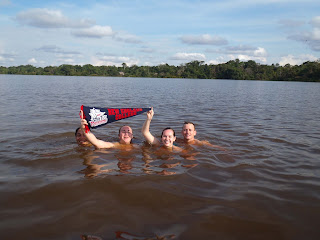Location: ARC Lodge, Esperanza, Iquitos, Lima, Miami, Boston, Henniker
Click here to view a web album containing 31 photos from today.
This blog entry will actually cover days #8 and #9, including our long journey home.
After a night full of thunderstorms (at times quite impressive ones, with loud torrential rain and frequent lightning), we all awoke for a 6AM breakfast. We realized that we would not be able to head out on our final boat ride - not because we are afraid of the rain, but because the animals tend to hide away in that weather. Instead, we attended a lecture by Alfredo, the resident biologists at the Amazon Research Center. He showed us his camera traps, infrared cameras that he stations around the research grid to help inventory the animal life.
It was fascinating to see photos of jaguars, tapirs, deer, anteaters, and various other mammals taken right where we had been walking the day before.
The morning was spent relaxing, showering, packing, and getting ready for the day as the rain stopped and a thick fog settled over the river.
We ate an early 11AM lunch, loaded the boat with our gear, and then posed for one final picture with the staff:
This photo shows our main guide Wennie (Wennington) on the bottom left (in the white T-shirt and hat), Elisa (a guide in training, just to his right in the yellow T-shirt), Haler (a local who helps on a temporary basis, and who loves to wield a machete) and Carolina (the 2nd-in-command guide, back row, white T-shirt, just to the right of Lori). Many of us bonded with our guides while there and we all benefited from the warmth and knowledge they shared with us. They were all greatly appreciated and will all be missed!
We managed to fit all of us and our luggage into the motorboat and headed downriver:
After about an hour, we reached Tahuayo Lodge, where we switched to a larger, faster motorboat. We headed upriver toward Iquitos. On the way, we stopped at Esperanza village, home to a clinic that services much of the area. Wennie explained that this clinic, paid for and sponsored by the tour company that runs the two lodges, provides treatment to locals, saving them lengthy and costly trips to Iquitos. We prepared a donation of a first aid kit and a variety of medications. Wennie and I walked into the village to hand over the supplies.
The nurses (who were quite amused at my height, laughing and saying they had never seen someone so big) asked me to explain the purpose of each item to make sure they understood. They were unfamiliar with many of them (Purell, Pepto Bismol, eye wash). If we ever return, I'd like to bring more serious supplies (surgical equipment, etc.).
We rode about 2.5 hours upriver to Iquitos, merging with the Amazon river, and passing through one final hard rainstorm along the way (which made for a rough journey).
We arrived in Iquitos and transferred to the bus. The ride to the airport was a panoply of colors and blurry motorbikes whizzing by.
We boarded a 5:30PM LAN flight to Lima
In Lima, we had several hours to shop for souvenirs and eat before boarding our midnight flight to Miami. We were all pretty bleary eyed upon landing as we worked our way through immigration, customs, baggage, etc., reaching our gate as our 7:15AM flight to Boston was loading. We landed in Boston by 10:30AM, indulged in a dozen Dunkin' Donuts (the taste of home!), and gathered our bags. Several of us were met by loved ones at the airport. The rest of us were ably spirited to Henniker on the NEC bus (thanks again, Dan!), arriving around 12:30PM.
It was sad to leave, but it's great to be home!
Thanks for reading.



























































